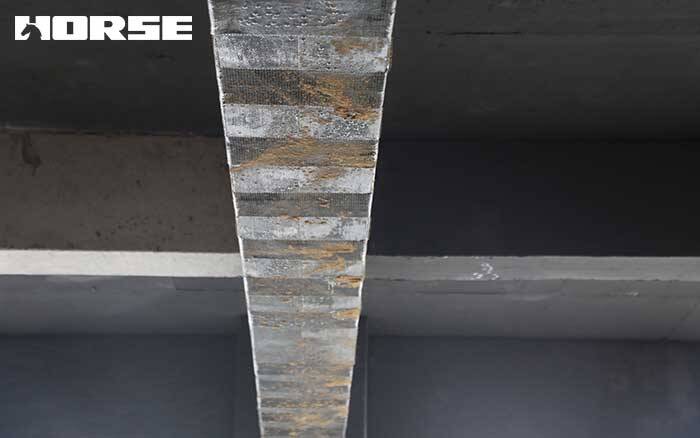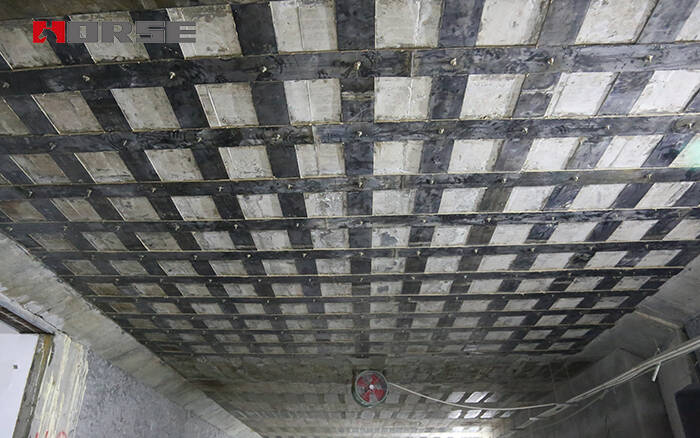Solutions
Horse Construction offers full range of structural strengthening materials with technical supports, documentation supports, products supports, project supports.
Right Structural Strengthening Method

The building structure will have its function weakened or destroyed under the action of various factors and the environment for a long time. During its long 50-year use period, the change of the use function is also an important factor that causes damage to the building structure. This requires us to master the scientific method of evaluating structural damage and adopt effective methods to ensure the safe use of the structure. Then, structural strengthening will become an important task.
Reinforced concrete structure strengthening methods we often use are the enlarged section method, the structure outsourcing steel method, and the carbon fiber strengthening method. In recent years, with the development of science and technology and economic improvement in our country, many new processes and technologies have emerged. How to choose the correct structural strengthening method?
Carbon fiber is a new type of material with high tensile strength and softness. Its tensile strength is 10 times higher than that of steel. The principle of carbon fiber strengthening is to bond the carbon fiber filaments in the carbon fiber cloth together with an adhesive so that they work together and bear the tension together. The key is the bonding material.
Although carbon fiber yarn has high strength, after it is processed into carbon fiber cloth, how to make them work together has become an important issue. We know that when a piece of cloth is under tension, it will first be broken from the position where the tensile stress is greatest, and then the whole piece of cloth will be gradually torn apart, the same is true for carbon fiber cloth. What we need to consider is how to bond individual fiber filaments together, or even bond several layers of fiber cloth together to work together to resist tension.
China is a country prone to earthquakes. Since the Wenchuan earthquake, the country has gradually improved the seismic performance of buildings. The two revisions of the building seismic code show that the country attaches great importance to building seismic resistance. In addition, a large-scale general survey of the seismic performance of primary and secondary schools is carried out, and earthquake-resistant strengthenings are carried out on the buildings of primary and secondary schools with hidden dangers.
Carbon fiber strengthening is used for reinforced concrete beams, slabs and shear walls. For concrete beams, it can be used to paste tensile steel bars instead of beams in the middle of the beam and at the supports to increase the bending resistance of the beam. For the strengthening of the shear strength of the beam, carbon fiber cloth can be pasted on both sides of the beam, and its function is equivalent to the stirrup under the action of shear. For concrete slabs, paste it directly on the concrete tension zone.
The carbon fiber reinforced concrete column is mainly wrapped with carbon fiber outside the column. For the lateral expansion of the concrete caused by the axial force on the column, the expansion deformation of the thick concrete that reaches the ultimate bearing capacity increases sharply. At this time, the carbon fiber wrapping plays a hoop constraint on the concrete. The improved ultimate compressive bearing capacity delays the time when concrete is crushed, gives full play to the bearing capacity of vertical steel bars, increases the ductility of reinforced concrete, and improves seismic performance.

External bonding steel strengthening method
Reinforced concrete beams and slabs belong to flexural components, and the flexural components have obvious tension areas and steel plates are glued to the surface of the tension area. Can greatly improve the component bearing capacity. Coupled with the vertical sticking of steel plates on both sides of the beam, the tension zone and the location where the shear force is insufficient can be improved in a targeted manner.
The external bonding steel strengthening method is simple in construction. The key parts are the surface treatment of the steel plate and the polishing of the concrete surface. There are many treatment methods for the surface of the steel plate. Generally, polishing and cleaning are common.
Concrete components generally have a mortar surface layer of 20mm on the surface. In recent years, the construction template technology has developed, and the concrete pouring is very smooth and smooth. Some projects have eliminated the mortar surface layer. In either case, the mortar surface layer should be removed first. Then polish the surface of the concrete to a thickness of 1 to 2 mm. The polished surface should be smooth. The important step after polishing is to blow off the dust, otherwise it will affect the bonding. The polished surface must be cleaned with acetone.
The same steel plate also needs to be processed. Use emery cloth or a grinder to polish the rust on the steel plate. The smooth surface without rust should also be polished to give a metallic luster. When polishing, it should be noted that the polishing direction should be perpendicular to the direction of force. Use acetone to clean the surface of the steel plate. The adhesive should be full on the bonding surface and there should be no hollow drum, otherwise it will affect the strength. Finally, care should be taken to protect the steel plate from any displacement and touch before reaching the strength.

External steel strengthening method
Outsourcing steel strengthening is to wrap the steel plate or angle steel on the outside of the reinforced component (such as beams and columns), and use epoxy resin to bond the steel plate or angle steel to the beams and columns into one body and bear the force together. The cross-section of the reinforced member does not change much, but the bending resistance and shear resistance of the member increase significantly.
The outsourcing steel strengthening method is simple on-site and easy for workers to master. The steel can be welded and cut on site. For the reinforced beams and columns, it is required to smooth the surface of the concrete and remove the dust to make the angle steel and steel plate close to the surface of the beam and column. The steel plate should be derusted first. The surface of the concrete and steel plate should be cleaned with xylene, and epoxy resin or latex cement should be applied to the cleaned angle steel and the surface of the beam and column, and then the bonding and positioning are carried out. This method can improve the load-bearing capacity of the component without increasing the cross-sectional area of the component, but its disadvantage is that it uses a large amount of steel.
Enlarged section strengthening method
There are two ways to increase the section method: increase the area of the compression zone and increase the area of the strengthening in the tension zone. In-situ concrete is poured in the compression zone of the concrete flexural member to increase the effective height of the section, expand the section area, increase the section height, and improve the bending and shear resistance of the concrete flexural member. The bearing capacity of the normal section of concrete is determined by the area of the tensile steel bars. In the case of no over-strengthening, increasing the area of the main strengthening can effectively improve the bearing capacity of concrete members. In addition, adding concrete to the tension zone increases the cross-sectional area of the component, which has the same effect as the original cross-section and steel bars to increase the bearing capacity of the component.
The enlarged section method has a direct effect on concrete components, simple construction technology, complete calculation formulas and construction methods, and easy to grasp. It is a commonly used construction method for the strengthening of beams, slabs and columns. Its disadvantages are that it requires wet work on site to remove part of the concrete, long working hours, poor on-site working environment, greater impact on the surrounding environment, high labor intensity, the concrete needs to be removed to expose the steel bars, and the site needs to be protected.
Concluding remarks
Any of the above structural strengthening methods should comprehensively consider environmental conditions, technical conditions, ease of construction, cost, and use functions after strengthening under the premise of ensuring safety. In short, the strengthening of concrete elements is a key measure related to building safety and affecting human life. In actual work, various factors should be considered comprehensively, the main technical characteristics should be analyzed, and the best plan should be selected according to the actual situation.
You can find anything here you are in need of, have a trust trying on these products, you will find the big difference after that.

High strength carbon fiber reinforced polymer (CFRP) strip / laminate / plate for structural strengthening and concrete repair

Two-component epoxy modified epoxy structural strengthening adhesive for bonded steel plate to concrete

High strength, unidirectional carbon fiber sheet pre-saturated to form a carbon fiber reinforced polymer (CFRP) sheet used to strengthen structural concrete elements.